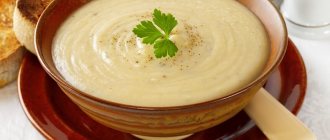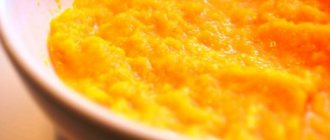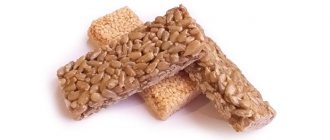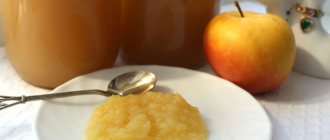If you don’t yet know where to start feeding your baby vegetables, the complementary feeding table and our selection of recipes for the best vegetable purees for first feeding will help you, which you can easily prepare at home.
Most often, the first feeding of a baby starts with vegetable puree from zucchini, cauliflower or broccoli. These are the most hypoallergenic vegetables, that is, those to which children usually do not have an allergic reaction. You should start with a monocomponent puree (a puree made from one vegetable), and then, when you have already introduced several different vegetables one at a time, and there is no allergic reaction to them, you can prepare vegetable purees from two or more proven vegetables.
In our selection you will find 12 of the best mono- and multi-component vegetable purees for baby’s first complementary foods, many of which can be prepared in just 15 minutes.
Vegetable puree from carrots for first feeding
Beta-carotene-rich carrots are a very important product in baby food. Follow our simple step-by-step instructions to learn how to introduce carrots into complementary foods and how to make carrot puree for your baby. For a recipe for vegetable complementary foods, see the link: How to introduce carrots into complementary foods: carrot puree for babies.
Broccoli is an ideal vegetable for baby's first feeding. We talk in detail about its beneficial properties in the article Broccoli in baby food. And now we want to share a recipe for how to cook broccoli for the first feeding.
The first vegetables - characteristics and features
To decide which vegetable puree is best to start with, you should familiarize yourself with the brief characteristics of the useful components and listen to the recommendations of doctors.
- Zucchini or squash. Ideal for children prone to allergies or overweight. Products help remove excess fluid from the body. Contraindicated for loose stools.
- Cauliflower. It has a high content of vitamin C, protein and iron. Suitable for overweight children.
- Broccoli. Leader in calcium content and a number of other important microelements. It almost never causes allergies or digestive disorders in an infant.
- Potato. Rich in vitamins, phosphorus and potassium. Before preparing puree from this vegetable, you need to soak the product in cold water (at least an hour). This will help wash away excess starch. The dish should be introduced into the diet of babies in minimal quantities; it is not recommended to give it to children with constipation.
- Carrot. Leader in vitamin A content and natural biologically active components. Children really like its pleasant taste. For the first feeding, it is recommended not to take risks and use only boiled carrots.
- Pumpkin. Low-calorie product, containing a lot of vitamins and pectin. Can be given to overweight children.
Regardless of whether the baby began to receive complementary foods from 4 months, or from six months, initially only monocomponent dishes should be present in his diet. After the baby gets used to them, you can prepare something more complex, but from already proven vegetables. When deciding on your baby's first complementary foods, you should choose from zucchini, cauliflower and broccoli. After getting used to it, you can add the rest of the listed products to the menu, as well as spinach and green peas. Tomatoes and beets can be offered no earlier than 9-10 months.
Vegetable puree from potatoes for first feeding
Potatoes have many beneficial properties: they have a positive effect on the digestive system, stabilize metabolism and strengthen the cardiovascular system. In addition, it is simply tasty, nutritious and easy to prepare according to our recipe, which you will find at the link: When to introduce potatoes into complementary foods and how to prepare them.
Vegetable puree from carrots and broccoli and cheese for complementary feeding
Combining broccoli with mashed potatoes and cheese is an excellent recipe for vegetable feeding, as it will help your baby eat more healthy greens. The fairly strong aroma of broccoli will complement the mild taste of mashed potatoes. Moreover, you remember that broccoli is a super vegetable: it is an excellent source of vitamin C, beta-carotene, folic acid, iron and potassium. You can find the full recipe at the link: Vegetable puree for the first feeding with broccoli and cheese (9-12 months).
Making puree
Many recipes do not contain anything complicated, so absolutely any young mother can prepare vegetable puree. The main need for preparing vegetable purees is to achieve the most homogeneous state. It would also be useful to consult with a pediatrician on how to properly introduce complementary foods. It’s better to start introducing vegetable puree into complementary foods with something you’ve prepared yourself. How to prepare baby puree?
Zucchini
When deciding which puree is best to start introducing your child to the first dish and which vegetables to choose, the choice falls on zucchini. This vegetable is particularly hypoallergenic and has a delicate texture after cooking.
How to make puree for babies, let's start:
- First you need to thoroughly wash and peel the zucchini. To prepare vegetable puree, just take 1-2 zucchini. It is advisable to choose the smallest fruits without any damage.
- Then you need to place the chopped vegetable in a saucepan and add a small amount of water. Steaming may be the most effective and convenient for many mothers.
- Cook for no more than 10 minutes. Grind the cooked vegetable in a blender until smooth.
Cauliflower
Cooking is not much different from cooking zucchini. It will take a little more water and time. When preparing a new dish, cooked vegetables also need to be pureed until smooth. It is permissible to dilute the puree with milk or milk mixture. This vegetable is most often introduced after zucchini. It has good compatibility with purees from other types of cabbage.
Broccoli
When introducing vegetable complementary foods, broccoli also ranks first in the vegetable rankings. When preparing it yourself, it is not always possible to achieve a completely homogeneous state. Therefore, there is no need to introduce complementary foods to the child before the above-mentioned vegetables. By this age, the baby will have already become accustomed to unfamiliar food, and it will be easier for him to move on to food with tiny grains.
The recipe also does not contain anything unusual: boil and grind.
Pumpkin
At what age should pumpkin be introduced? The first vegetables are offered to the baby at 4-6 months. Sometimes you can come across the statement that pumpkin puree strengthens the baby’s stool. This is a rare occurrence; usually, eating pumpkin dishes, on the contrary, softens the baby’s stool.
Recipes for vegetable purees for infants by month suggest the early introduction of pumpkin into the diet.
The most suitable option would be to bake the vegetable in foil. However, not every young mother is ready to heat up an electrical appliance for the sake of a tiny piece. Therefore, it is quite acceptable to boil the pumpkin in a small saucepan or steam it. A mature vegetable cooks for quite a long time due to the large amount of plant fiber it contains, but the cooking time should not exceed 30 minutes.
The finished piece should also be crushed with a blender. The result is a tender puree that is in no way inferior to commercially available analogues.
Potato
The puree is prepared in the traditional way. There is no need to rush into introducing this dish. Its addition to the baby’s menu should be postponed until the very last date of introduction of complementary foods. When preparing puree, it is necessary to mix at least half with others. During cooking, most of the vitamin C is lost. However, the remainder can meet the child’s needs.
Vegetable puree from pumpkin with prunes and yogurt for complementary feeding
The main advantage of this pumpkin puree for babies is that it is rich in vitamin A, beta-carotene, potassium, protein and iron. And by mixing pumpkin with yogurt and prunes, your child will not only receive a large dose of beneficial bacteria that will improve his digestion, but also a lot of fiber that will help to easily cleanse the intestines, which is especially important for children who suffer from constipation. Recipe at the link: How to make pumpkin puree for babies in 15 minutes.
Porridge for first feeding
On store shelves you can see porridges: - dairy, dairy-free; — mono- and multicomponent; - gluten-free (low-allergenic) and gluten-free; - containing various additives; - therapeutic and prophylactic. What is what and what is it eaten with?
Each porridge has its own time of administration, its own purpose or contraindications. We'll figure out. When choosing milk or dairy-free porridge, you should take into account whether the baby has lactase deficiency or an allergy to cow's milk protein, since milk porridges are made on the basis of milk formula. At the age of 6 months, the mother should already know this feature of the baby and it is better not to conduct experiments.
When choosing a one- or multi-component porridge, you definitely need to start with a single-component product and watch the reaction. When several one-ingredient cereals have already been tried, you can begin to give your baby their various variations. Gluten and gluten-free cereals are selected based on whether the baby has gluten intolerance.
Gluten is a plant protein that can be a source of allergies, so introducing porridge into your baby’s menu should be treated with caution, following the rules for introducing a new product. If any reaction appears (rash, gastrointestinal upset, etc.), you can suspect that the baby has gluten intolerance (that is, a deficiency or absence of an enzyme in the baby that breaks down gluten).
Gluten is found in oatmeal, wheat groats, semolina, pearl barley and barley groats. Buckwheat, rice, corn grits and millet, on the contrary, do not contain gluten, so they are more rational for first feeding.
Porridges that contain additives are understood as those with the addition of a fruit or vegetable component, for example, buckwheat-apple, etc. It is good to introduce them a little later, when the child is well acquainted with each component element separately. Therapeutic and prophylactic include porridges with the addition of prebiotics, lactulose, etc., intended for feeding babies with any health problems or for preventive purposes.
Different grains are needed, different grains are important
Rice is best for introducing porridges, since it does not contain vegetable protein and is digested quite well. At the same time, if a child is prone to constipation, then it is more rational to start with buckwheat, since it contains more fiber and it stimulates intestinal motility well. It is also a champion in iron content, which is indispensable for babies with low hemoglobin.
Next in line are corn grits (it is somewhat more difficult to digest and absorb than rice and buckwheat, but contains fewer calories, so it definitely won’t lead to problems with excess weight), oatmeal (contains a lot of vegetable fat, as well as essential amino acids), millet ( It contains less nutrients than other cereals and is more difficult to digest, so it is recommended to include it in the diet after a year). Paradoxically, the notorious semolina ranks last among porridges, since it contains the largest amount of gluten and a lot of starch, despite the fact that, on the contrary, there is little useful fiber and vitamins.
Give complementary foods in the morning or evening
As a rule, pediatricians recommend giving porridge in the morning as breakfast. But lately there has been a tendency to move porridge to the evening, before bed. This is motivated by the fact that after a more high-calorie and nutritious dinner, the child sleeps sounder and more peacefully at night, and also gains weight better (which is especially important for low-weight children). But one way or another, the final nutrition plan is drawn up by the mother herself, and she chooses what is more convenient for her and her child.
Brew or buy? Provided that the mother introduces complementary feeding according to the pedagogical scheme, that is, gives food in microdoses from her plate, then the answer is clear - the mother herself prepares the porridge.
If the complementary feeding option is pediatric, then, as in the situation with vegetables, most experts are inclined to industrially produced cereals, citing the fact that in this way the beneficial substances in the porridge can be preserved as much as possible, and in multi-component cereals it is most easily digestible for the child’s fragile digestive system various ingredients are combined. At the same time, the cereals from the box always contain recommendations for the baby’s age.
If mom decides to cook porridge herself, there are several points to consider. You need to cook the porridge in water; you can add expressed milk (if breastfeeding) or an adapted milk formula (if formula-fed) to the finished product; later you can also add butter.
It is better not to use cow's milk for this purpose. A 5% concentration is a good place to start, i.e. 5g of porridge contains 95 ml of liquid. Then you can gradually increase the percentage to 10%, so the porridge will become thicker each time. Well-boiled cereal must be crushed (rubbed through a sieve or using a blender) to the desired consistency.
Vegetable puree from carrots, sweet potatoes, peppers with chicken for complementary feeding
If your child has already tried monocomponent vegetable and meat purees as first complementary foods, you can offer him this bright, tasty, and most importantly healthy carrot puree with chicken, sweet peppers and sweet potatoes, the recipe for which you will find in the link.
Read also: Pumpkin and apple puree for babies (Recipe)
Read also: Fish puree for children under one year old (Recipe)
Read also: Homemade cottage cheese for first feeding











